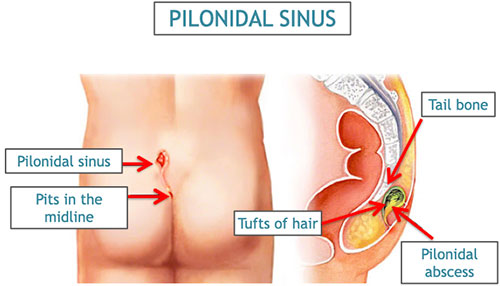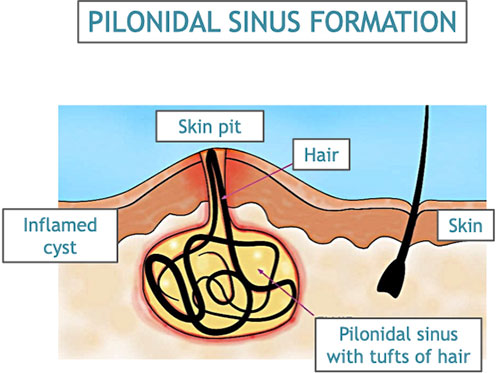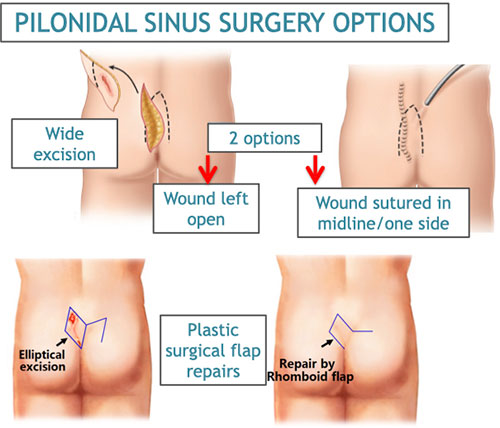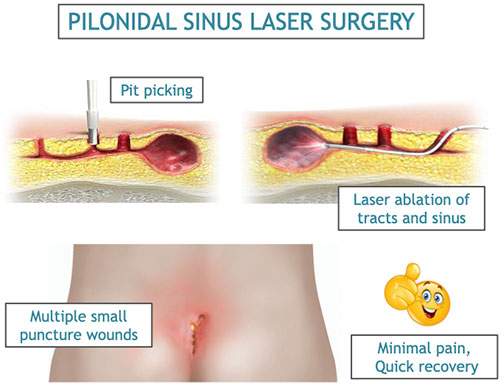PILONIDAL SINUS
What is a pilonidal sinus?

Pilonidal sinus is a tract in between or just above the buttocks (near the tail bone), that is formed under the skin due to tufts of hair.
Pilonidal sinus is associated with pain, swelling and watery or pus discharge. It is also called Jeep Driver’s Bottom. Sometimes, it can even occur at the belly button. It can be a source of constant or frequent suffering.
How does a pilonidal sinus occur?
Hair from the back or head falls near the small of the back, it often gets trapped against the skin. This coarse hair, then burrows under the skin, resulting in a small infected area which gradually forms a tunnel.
When pus collects to a significant extent in the pilonidal sinus, it forms an abscess (or boil). This can be quite painful. Even after the pus is drained from such boils, a new abscess will eventually form again, till the pilonidal sinus is treated.

Pilonidal sinus are more likely in the following people:
- Males: most commonly in young men. It can however also happen in women.
- Those who wear tight clothes
- Those with excessive body hair
- hose who spend a significant amount of time in a chair while working or driving.
- Those with dry, itch skin
- Those predisposed to infections, such as people with diabetes, lowered immunity, etc.
Persons from the same family as someone suffering from pilonidal sinus are at a higher risk. This is usually due to a similar body type and lifestyle habits. Pilonidal sinus is not known to have a genetic relationship.
What are the symptoms of pilonidal sinus?
Symptoms of pilonidal sinus include:
- itching, mild burning, and pain at the upper edge/between the buttocks
- watery/ yellowish discharge in between the buttocks(for example, you might see find a stickiness or wetness in between your buttocks, almost like sweat)
- swelling and tenderness just above the buttocks
How is pilonidal sinus diagnosed?
Your health care provider will examine your lower back and buttocks. If the area is swollen, you might feel some discomfort when the area is being examined. Sometimes your examiner may check your anal region or rectum, to differentiate a pilonidal sinus from a perianal fistula.
To confirm the presence of a pilonidal sinus tract and to get a proper map of the area, your health care provider may ask for an MRI scan of the region.
What is the treatment of pilonidal sinus?
A pilonidal sinus is treated by surgery. The entire tract along with the hair inside, along with collected pus must be removed. Antibiotics and pain killers are given when there is an infection, and sometimes an abscess may have to be drained, followed by a definitive surgery later.
What are the surgical options for pilonidal sinus?

Classically, the following surgical options have been used to treat Pilonidal sinus:
- Removal of the tract only (sinusectomy), which is insufficient due to high chance of a potion of the tract/ hair being left back, causing incomplete treatment.
- Excision of the entire region (Lord and Millar technique), leaving a large wound in the middle of the back and upper buttocks sometimes to one side (Bascom technique). These techniques result in a large wound that takes about 2-3 months to heal, and is associated with significant scarring.
- Excision of tract and closure of wound with sutures (primary closure), which are also sometimes buried in tracts with an open wound at the lower end (Kyridakis technique). The risk of sinuses reforming with these techniques is high.
- Excision of tract with a VY flap or with a rhomboid flap (Limberg technique), which involves transferring skin from the surrounding area onto the wound. This technique is extensive, but can still have recurrence of pilonidal sinus.

The newer techniques of pilonidal sinus treatment are as follows:
- Video-assisted/ endoscopic pilonidal sinus treatment (EPSiT) - This new technique involves passing a small scope into the pilonidal sinus and cleaning up the tract and removing any hair stuck in the sinus. It results in a smaller wound and minimises damage to the surrounding area.
- Laser pilonidal sinus surgery: This is the newest treatment for pilonidal sinus and has shown promising results. The entry points in the skin from where the hair caused the sinus are removed by 3 mm cuts with a special round knife called a dermatome. The tract is then cleaned up and treated with a special diode laser which burns out the infection from within, while protecting the surrounding skin and minimises damage to surrounding nerves and vessels. The area heals within 2-3 weeks.
What are the diet and lifestyle modifications for treatment of pilonidal sinus?
After the surgery and recovery of the area, it is recommended to use a hair-removal cream or laser hair removal for the surrounding area, especially in persons with coarse hair. This minimises chances of a new pilonidal sinus occurring in the future. Speak to your healthcare adviser for more details on how to carry this out.
Control of diabetes is important for healing and for treatment of infection in such people. Apart from this, there are no dietary restrictions.
Lifestyle changes such as skin and hair care, sitting habits and posture will also help prevent a pilonidal sinus.